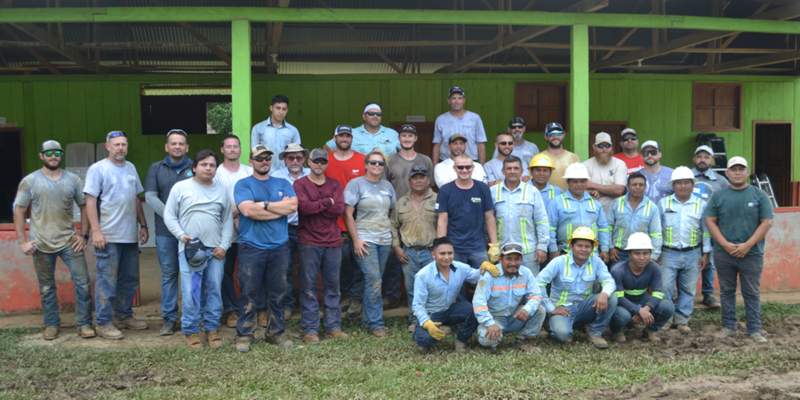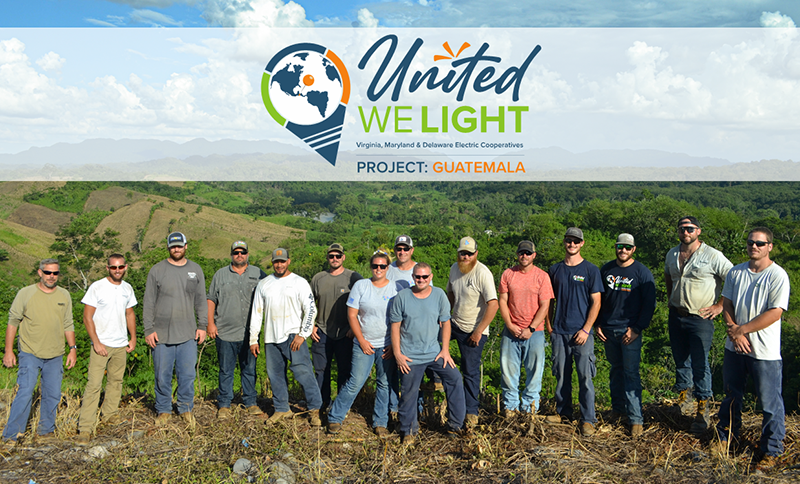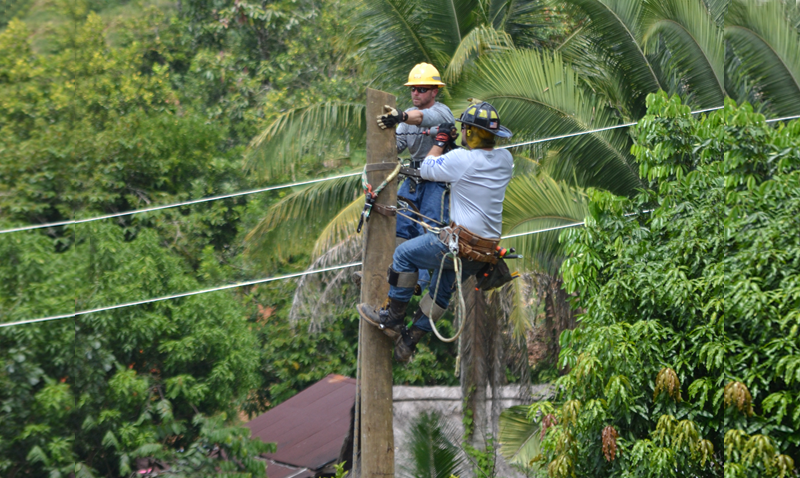Mid-Atlantic Line Workers Bring Gift of Power to Guatemala

Last October, a team of 19 volunteer line workers from 10 Virginia, Maryland and Delaware cooperatives spent nearly three weeks in Guatemala, bringing electricity, for the first time, to the rural village of Santa Isabel. Among the 19 volunteers was the first-ever female line worker to participate in an NRECA International project. CFC and NCSC were proud to support this effort with grants totaling $70,000 to help cover trip expenses.
This was the second successful international mission by the Virginia, Maryland and Delaware Association of Electric Cooperatives (VMDAEC), after the United We Light team completed a similar trip to Bolivia in 2019.
The VMDAEC team was not expecting to participate in an international project in 2023 due to the backup of projects caused by the COVID pandemic, which shut down the international electrification program for nearly three years. But when they were contacted by NRECA International in the first quarter of 2023 with news that a project in Guatemala had opened up, the United We Light team jumped at the opportunity.
 Photo credit to John Johnston of SMECO.
Photo credit to John Johnston of SMECO.
“We, as Americans, were in the same shoes as Guatemala not so long ago,” VMDAEC president and CEO Brian Mosier said. “It wasn’t until the passing of the Rural Electrification Act of 1936 when we finally saw the gift of power being brought to rural areas of our nation through electric cooperatives,” he explained about the importance of international projects.
“Fortunately, most of us in the U.S. do not know a life without electricity, which makes us take a lot for granted,” Mosier said. “Supporting these projects doesn’t just brighten the inside of a home, it brightens everyone’s future. It provides a better means of farming, working, cooking, educating and communicating.”
Local Protests Cause Challenges
In addition to working in more than 100-degree weather with high humidity across unfamiliar terrain and with limited equipment—no bucket or line trucks—the VMDAEC team also had to contend with logistical problems caused by a series of political protests as soon as they arrived in the country.
The protests, involving thousands of Guatemalans who blocked streets and bridges and made it extremely difficult to move around the area, were in response to alleged interference in the August presidential election victory of anticorruption candidate Bernardo Arévalo, who was eventually sworn into office in January.
“The team faced heavy travel delays in the country due to the peaceful protests that were staged on major roadways,” J.T. Jacobs, manager of safety training at VMDAEC and co-leader of the project, said. “This slowed us down and presented issues for refueling our transport vehicles. One time, when gas stations ran out of fuel, we had to improvise by sending an ambulance to Mexico to fill up 40-gallon rain barrels with diesel and siphon the fuel into our pickups.”
On a near-daily basis, the team had to figure out how to travel the roughly 30 miles back and forth from where they were staying to the 500-person village of Santa Isabel, north of Guatemala City, in the face of the protests.
“We approached each road blockage we came across with caution, but were able to make headway with the protestors by explaining our purpose for being there and asking for safe passage,” Jacobs said. “Some would allow us through, and some wouldn’t.”
Often, the team had to be creative. “Just after completing the project, we saw traffic moving and quickly packed our belongings and hit the road for Guatemala City,” Jacobs said. “Two hours into our drive, we came to a roadblock. Some of the locals told us this one would last for days. As we were preparing to camp out in our vehicles for the rest of the night, our lead engineer found an alternate, 12-hour route to the city. We took our chances and took turns driving all through the night and made it to the airport.”
Despite these obstacles, the team finished all the project work on schedule, installing three miles of primary line, two miles of secondary line, seven overhead transformers and 103 meter bases. A total of 103 homes were wired internally to support two lights, an outlet and a switch. They also hooked up the village school.
The team worked across 84 new utility poles that had been set, but not framed, by the local utility Empresa Municipal Rural de Electricidad (EMRE).
“I was told by the lead NRECA International engineer that this was the second-largest project he had been a part of in his longstanding time there,” Jacobs said.
 Photo credit to John Johnston of SMECO.
Photo credit to John Johnston of SMECO.
Local Help Gets It Done
In addition to setting the poles prior to the U.S. team’s arrival, EMRE workers helped on the project and will be responsible for maintaining the new line going forward.
“They worked side by side with us every day through the entirety of the project,” Jacobs said. “We may not speak the same language, but the work was a language that both groups understood.”
The villagers also helped. “The road to Santa Isabel and the right of way were unpaved and very muddy, and our trucks kept getting stuck the first day,” Jacobs said. “The villagers saw our struggles and came to our aid by carrying rocks on their backs from the fields and dumping them in the rutted-out pathways to give our vehicles traction.”
Both the EMRE workers and the villagers were also impressed by Northern Neck Electric Cooperative line technician Gena Boarman.
“Gena fit in perfectly with everyone,” Jacobs said. “She’s a hard worker and a great line worker.” The local villagers and EMRE were definitely in awe that a woman was climbing poles and doing line work. In the beginning, a crowd would build up around her work site.”
Although the work was grueling, and the experience challenging to say the least, the volunteers came away feeling it was all worthwhile.
“There were definitely some uncomfortable moments with all the challenges we faced,” Jacobs said. “But the team was glad we didn’t just pack up and go back home when faced with these obstacles. Everyone knew deep down that we were there for a bigger reason than ourselves—and that was providing a better future and more opportunities for a less fortunate community. Everyone has communicated to me that they would go back tomorrow and help again if they could.”
Powhatan, Virginia-based Southside Electric Cooperative line worker Scott Geovannello shared, “It’s the hardest thing I’ve put myself through but I’m very grateful I decided to go on this journey.”
Fredericksburg, Virginia-based Rappahannock Electric Cooperative line worker Drew Leake added, “I’m really grateful for the opportunity. It’s hands down the best thing I’ve ever done.”
And the villagers were extremely appreciative of all the work that was accomplished for them. Beyond just being able to see at night, electricity enables them to run farm machinery, power tablets and other education-related tools at the school and play soccer on a lighted field at night for the first time.
“I was told by one of the villagers that electricity helps people stay in Santa Isabel instead of moving elsewhere,” Jacobs explained. “It helps families remain together in their hometown. It’s more than just turning a light on. It’s making dreams come true.”
CFC and NCSC Support Was Vital
“The CFC and NCSC funds were very important to the project as it reduced the overall cost per participant by $4,000,” Mosier said. “It’s an expensive trip for our member co-ops, so that helped recruitment when we first promoted the project.”
He shared that the project received a lot of positive feedback from member cooperatives and their members. Mosier stated, “It was unanimous among our member co-ops that we should participate in the next international trip that is available. It looks like 2026 is a possibility to go back to Guatemala, so we will certainly let CFC and NCSC know if that schedule solidifies.”